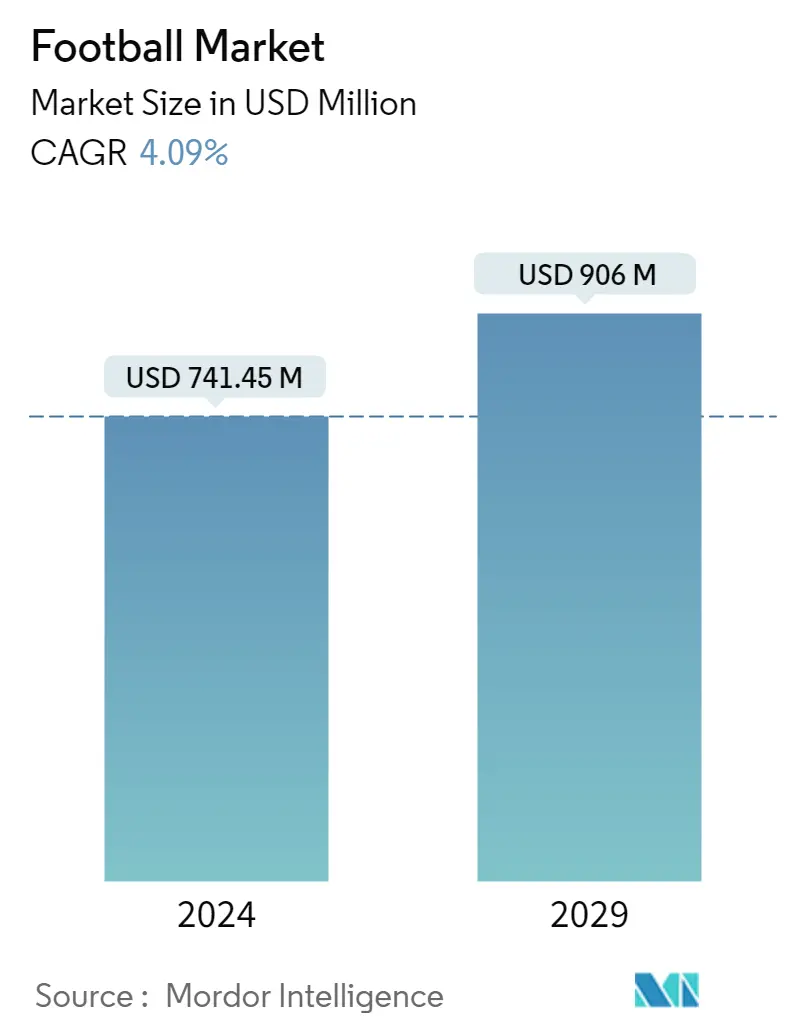Market Size of Football Industry

| Study Period | 2019 - 2029 |
| Market Size (2024) | USD 741.45 Million |
| Market Size (2029) | USD 906.00 Million |
| CAGR (2024 - 2029) | 4.09 % |
| Fastest Growing Market | Asia Pacific |
| Largest Market | Europe |
Major Players
*Disclaimer: Major Players sorted in no particular order |
Football Market Analysis
The Football Market size is estimated at USD 741.45 million in 2024, and is expected to reach USD 906 million by 2029, growing at a CAGR of 4.09% during the forecast period (2024-2029).
The COVID-19 outbreak has significantly affected the market due to several national and international tournament closures worldwide. Some of these major events are the FIFA World Cup, UEFA Champions League, UEFA European Championship, Copa America, Copa Libertadores, UEFA Europa League, Africa Cup of Nations, etc. However, post-covid, the market is recovering fast, which is boosting the sales of sports products worldwide. During the pandemic, Nike, a major player in the sport, estimated a sales decline, but the company saw a big recovery in sales after the pandemic ended. According to the company, NIKE's annual revenues for 2022 were USD 46.71 billion, a 4.88% increase from 2021. In 2021, Nike's annual revenue was USD 44.538 billion, a 19.08% increase over the previous year. In 2020, Nike reported annual revenues of USD 37.403 billion, a drop of 4.38% from 2019's USD 39.628 billion.
Individuals are becoming increasingly involved in fitness and sports activities, which is driving the global market. As football's popularity increases and the number of young adults participating in football-related events increases, this trend is likely to continue. In addition, the products are readily available through online and offline organized retail channels, which is driving the market growth. In addition to the increased consumer expenditure on sports and recreation activities, continued product innovation, the growing use of fitness apps among health-conscious individuals, and extensive research and development (R&D) activities conducted by key players are some positive factors impacting this market.
Football Industry Segmentation
Football, also called association football or soccer, involves two teams of 11 players trying to maneuver the ball into the other team's goal without using their hands or arms. The football market is segmented by size, distribution channel, and geography. Based on the size, the market is segmented into Size 1, Size 2, Size 3, Size 4, and Size 5. Based on the distribution channel, the market is segmented into specialty stores, supermarkets/hypermarkets, online stores, and other distribution channels. Also, the study analyzes the dietary supplements market in emerging and established markets worldwide, including North America, Europe, Asia-Pacific, South America, the Middle East, and Africa. For each segment, the market sizing and forecasts have been done based on value (in USD million).
| Size | |
| Size 1 | |
| Size 2 | |
| Size 3 | |
| Size 4 | |
| Size 5 |
| Distribution Channel | |
| Specialty Stores | |
| Supermarkets and Hypermarkets | |
| Online Stores | |
| Other Distribution Channels |
| Geography | |||||||||
| |||||||||
| |||||||||
| |||||||||
| |||||||||
|
Football Market Size Summary
The football market is experiencing a robust recovery post-COVID-19, driven by the resurgence of international tournaments and increased consumer engagement in sports and fitness activities. The pandemic had initially caused significant disruptions, impacting major events like the FIFA World Cup and UEFA Champions League, but the market is now rebounding, with a growing interest in football worldwide. This resurgence is fueled by the rising popularity of football, particularly among young adults, and the availability of football products through both online and offline retail channels. The market is further bolstered by increased consumer spending on sports, ongoing product innovation, and the widespread use of fitness apps, all contributing to a healthier lifestyle. Government initiatives and programs by organizations like the FIFA Foundation are also playing a crucial role in promoting football, enhancing participation rates, and supporting mental health awareness.
Europe stands out as the largest football market, with a significant number of participants and clubs driving demand across all age groups. This presents lucrative opportunities for foreign manufacturers to expand their presence in the region. The market is highly competitive, with major players like Adidas and Nike leading the charge in product innovation, such as developing footballs with advanced stability features and customization options. The growing involvement of women in football is also noteworthy, with increased sponsorships and the establishment of professional women's clubs, particularly in Europe. These developments are attracting more consumers to invest in high-quality football products, further propelling market growth.
Football Market Size - Table of Contents
-
1. MARKET DYNAMICS
-
1.1 Market Drivers
-
1.2 Market Restraints
-
1.3 Porter's Five Forces Analysis
-
1.3.1 Threat of New Entrants
-
1.3.2 Bargaining Power of Buyers/Consumers
-
1.3.3 Bargaining Power of Suppliers
-
1.3.4 Threat of Substitute Products
-
1.3.5 Intensity of Competitive Rivalry
-
-
-
2. MARKET SEGMENTATION
-
2.1 Size
-
2.1.1 Size 1
-
2.1.2 Size 2
-
2.1.3 Size 3
-
2.1.4 Size 4
-
2.1.5 Size 5
-
-
2.2 Distribution Channel
-
2.2.1 Specialty Stores
-
2.2.2 Supermarkets and Hypermarkets
-
2.2.3 Online Stores
-
2.2.4 Other Distribution Channels
-
-
2.3 Geography
-
2.3.1 North America
-
2.3.1.1 United States
-
2.3.1.2 Canada
-
2.3.1.3 Mexico
-
2.3.1.4 Rest of North America
-
-
2.3.2 Europe
-
2.3.2.1 Germany
-
2.3.2.2 United Kingdom
-
2.3.2.3 France
-
2.3.2.4 Spain
-
2.3.2.5 Italy
-
2.3.2.6 Russia
-
2.3.2.7 Rest of Europe
-
-
2.3.3 Asia-Pacific
-
2.3.3.1 China
-
2.3.3.2 Japan
-
2.3.3.3 India
-
2.3.3.4 Australia
-
2.3.3.5 Rest of Asia-Pacific
-
-
2.3.4 South America
-
2.3.4.1 Brazil
-
2.3.4.2 Argentina
-
2.3.4.3 Rest of South America
-
-
2.3.5 Middle-East and Africa
-
2.3.5.1 South Africa
-
2.3.5.2 Saudi Arabia
-
2.3.5.3 Rest of Middle-East and Africa
-
-
-
Football Market Size FAQs
How big is the Football Market?
The Football Market size is expected to reach USD 741.45 million in 2024 and grow at a CAGR of 4.09% to reach USD 906.00 million by 2029.
What is the current Football Market size?
In 2024, the Football Market size is expected to reach USD 741.45 million.

